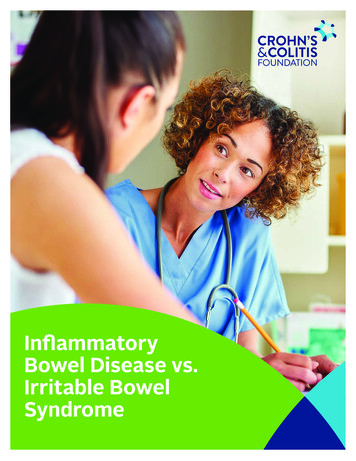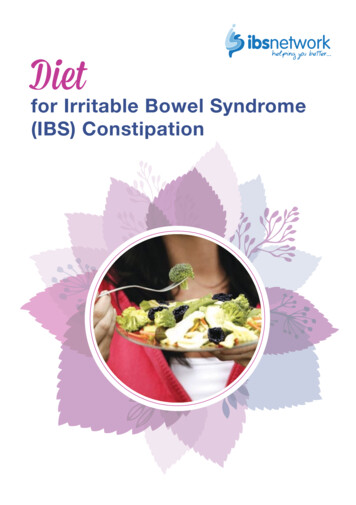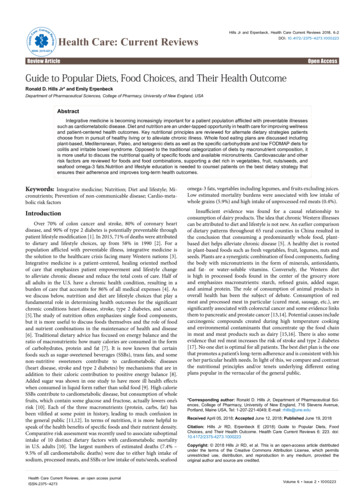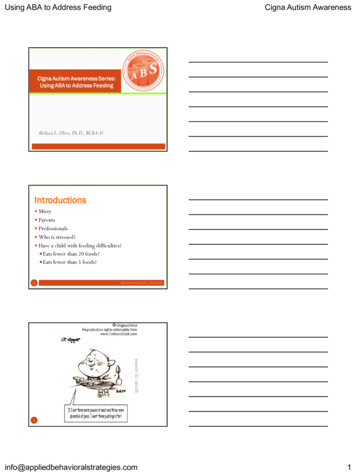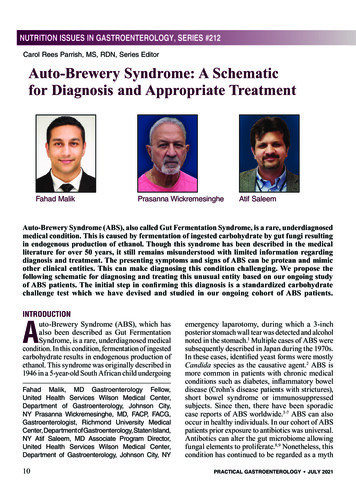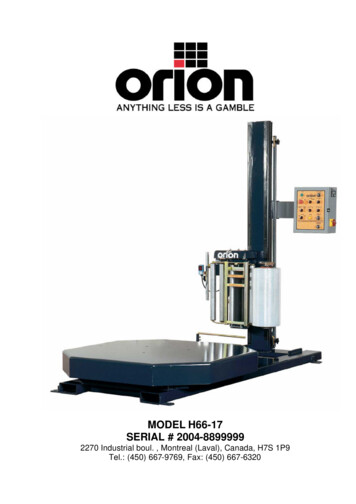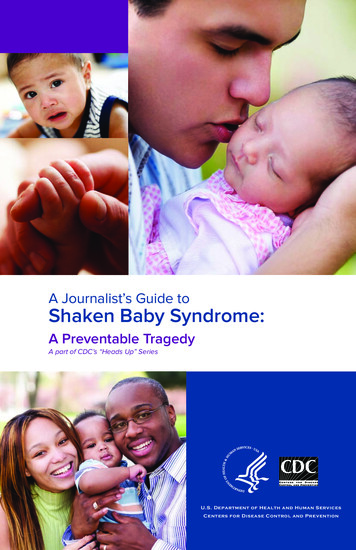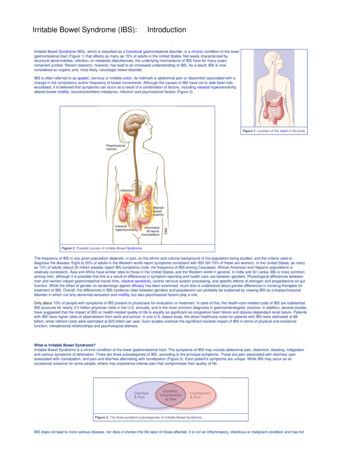
Transcription
Irritable Bowel Syndrome (IBS):IntroductionIrritable Bowel Syndrome (IBS), which is classified as a functional gastrointestinal disorder, is a chronic condition of the lowergastrointestinal tract (Figure 1) that affects as many as 15% of adults in the United States. Not easily characterized bystructural abnormalities, infection, or metabolic disturbances, the underlying mechanisms of IBS have for many yearsremained unclear. Recent research, however, has lead to an increased understanding of IBS. As a result, IBS is nowconsidered an organic and, most likely, neurologic bowel disorder.IBS is often referred to as spastic, nervous or irritable colon. Its hallmark is abdominal pain or discomfort associated with achange in the consistency and/or frequency of bowel movements. Although the causes of IBS have not to date been fullyelucidated, it is believed that symptoms can occur as a result of a combination of factors, including visceral hypersensitivity,altered bowel motility, neurotransmitters imbalance, infection and psychosocial factors (Figure 2).Figure 1. Location of the colon in the body.Figure 2. Possible causes of Irritable Bowel Syndrome.The frequency of IBS in any given population depends, in part, on the ethnic and cultural background of the population being studied, and the criteria used todiagnose the disease. Eight to 20% of adults in the Western world report symptoms consistent with IBS (60-70% of these are women). In the United States, as manyas 15% of adults (about 35 million people) report IBS symptoms (note: the frequency of IBS among Caucasian, African American and Hispanic populations isrelatively consistent). Asia and Africa have similar rates to those in the United States, and the Western world in general. In India and Sri Lanka, IBS is more commonamong men, although it is possible that this is a result of differences in symptom reporting and health care use between genders. Physiological differences betweenmen and women impact gastrointestinal transit time, visceral sensitivity, central nervous system processing, and specific effects of estrogen and progesterone on gutfunction. While the effect of gender on seratonergic agents efficacy has been examined, much less is understood about gender differences in nondrug therapies fortreatment of IBS. Overall, the differences in IBS incidence rates between genders and populations can probably be explained by viewing IBS as a biopsychosocialdisorder in which not only abnormal sensation and motility, but also psychosocial factors play a role.Only about 10% of people with symptoms of IBS present to physicians for evaluation or treatment. In spite of this, the health-care related costs of IBS are substantial.IBS accounts for nearly 3.5 million physician visits in the U.S. annually, and is the most common diagnosis in gastroenterologists’ practice. In addition, several studieshave suggested that the impact of IBS on health-related quality of life is equally as significant as congestive heart failure and dialysis-dependent renal failure. Patientswith IBS have higher rates of absenteeism from work and school. In one U.S.-based study, the direct healthcare costs for patients with IBS were estimated at 8billion, while indirect costs were estimated at 25 billion per year. Such studies overlook the significant societal impact of IBS in terms of physical and emotionalfunction, interpersonal relationships and psychological distress.What is Irritable Bowel Syndrome?Irritable Bowel Syndrome is a chronic condition of the lower gastrointestinal tract. The symptoms of IBS may include abdominal pain, distention, bloating, indigestionand various symptoms of defecation. There are three subcategories of IBS, according to the principal symptoms. These are pain associated with diarrhea; painassociated with constipation; and pain and diarrhea alternating with constipation (Figure 3). Each patient’s symptoms are unique. While IBS may occur as anoccasional nuisance for some people, others may experience intense pain that compromises their quality of life.Figure 3. The three symptom subcategories of Irritable Bowel Syndrome.IBS does not lead to more serious disease, nor does it shorten the life span of those affected. It is not an inflammatory, infectious or malignant condition and has not
been found to lead to colitis. Furthermore, IBS is not a psychiatric disorder, although it is tied to emotional and social stress, which can affect both the onset andseverity of symptoms. While IBS is not considered a life-threatening disease, IBS patients suffer from a disproportionately higher rate of co-morbidity with otherdisorders, such as fibromyalgia, chronic fatigue, pelvic pain and psychiatric disorders.Primary features of the syndrome include motility, sensation and central nervous system dysfunction. Motility dysfunction may be manifest in muscle spasms;contractions can be very slow or fast. An increased sensitivity to stimuli causes pain and abdominal discomfort. Researchers also suspect that the regulatory conduitbetween the central and enteric pathway in patients suffering from IBS may be impaired.Research suggests that many patients with Irritable Bowel Syndrome have disorganized and appreciably more intense colonic contractions than normal controls. Astudy at Johns Hopkins reported that healthy volunteers had 6–8 peristaltic contractions in the colon in a 24-hour period. In contrast, IBS volunteers in whom theprimary symptom was constipation had almost no contractions, and IBS volunteers in whom the primary symptom was diarrhea had as many as 25 contractions aday. Researchers have also found that pain is frequently associated with irregular motor activity of the small intestine when compared with either normal controls orpatients with Inflammatory Bowel Disease. Patients with this disease appear to have a defect of visceral pain processing—although whether or not this is a truehypersensitivity or hyper-vigilance remains controversial. Interestingly, however, ileal and rectosigmoid balloon-distention studies have demonstrated that patients withIBS experience pain and bloating at balloon pressures and volumes that are significantly lower than those which cause symptoms in normal controls.PathophysiologyThe biopsychosocial model of IBS integrates a number of psychosocial, motility, sensory abnormalities and abnormalities in central nervous system processing ofvisceral pain as the causes of abdominal pain and altered bowel habits (Figure 4.)Figure 4. The biopsychosocial model of Irritable Bowel Syndrome.Motor dysfunction contributes to some symptoms of IBS, such as abdominal pain, defecatory urgency, and postprandial bowel movements. Rapid small bowel andcolonic transit times have been reported in patients with diarrhea-predominant IBS. Patients with constipation-predominant IBS may have a component of disordereddefecation, resulting, at least in part, from abnormal function of the pelvic floor and anal sphincter muscles. Another factor in motor dysfunction is the abnormalpassage and handling of gas.Colonic and rectal hypersensitivity (also called “visceral hyperalgesia”) are also important factors in the causation of symptoms. Enteric propulsion and sensation are,in part, mediated by acetylcholine and serotonin (5HT).The physiology of sensation in the gut is multifaceted. Enteroendocrine cells transmit mechanical and chemical messages. The communication between gut and brainresults in reflex responses mediated at three levels—prevertebral ganglia, spinal cord and brainstem. 5-HT, substance P, CGRP, norepinephrine, kappa opiate andnitric oxide are all involved in the perception and autonomic response to visceral stimulation (Figure 5). Sensation is conveyed from the viscus to the consciousperception via neurons in vagal and parasympathetic fibers. Afferent nerves in the dorsal root ganglion synapse with neurons in the dorsal horn. These signals resultin reflexes that control motor and secretory functions as they synapse with efferent paths in the prevertebral ganglia and spinal cord. Pain is processed through spinalafferents in the dorsal horn. Ultimately, stimulation of the brainstem brings sensation to a conscious level (Figure 6). Bidirectional signaling between the brainstem andthe dorsal horn mediate sensation. The descending pathways are primarily adrenergic and serotonergic and affect incoming stimuli. End organ sensitivity, stimulusintensity changes or receptive field size of the dorsal horn neuron and limbic system modulation are the mechanisms involved in visceral hypersensitivity.Figure 5. Nerve cell communication in the wall of the colon.
Figure 6. Sensory pathway in Irritable Bowel Syndrome: an animated sequence (To view, click on the imageabove).Enteric inflammatory cells may also play an important role in the pathophysiology of Irritable Bowel Syndrome. Clinicians have for many years recognized that theonset of IBS often follows an episode of acute gastroenteritis. Inflammation may alter intestinal cytokine milieu and motility, both of which can result in an increase in apatient’s pain sensation. The menstrual cycle may also affect gut sensation and motility. Other factors, such as malabsorption of sugars (lactose, fructose, andsorbitol), probably aggravate underlying IBS, rather than serving as root causes of the disorder. In patients with rapid transit times, short or medium chain fatty acidscan reach the right colon and cause diarrhea.SymptomsThe hallmark of IBS is abdominal pain or discomfort associated with either a change in bowel habits or disordered defecation. The pain or discomfort associated withIBS is often poorly localized and may be migratory and variable. It may occur after a meal, during stress or at the time of menses. In addition to pain and discomfort,altered bowel habits are common, including diarrhea, constipation, and diarrhea alternating with constipation. Patients also complain of bloating or abdominaldistension, mucous in the stool, urgency, and a feeling of incomplete evacuation. Some patients describe frequent episodes, whereas others describe longsymptom-free periods. Patients with irritable bowel frequently report symptoms of other functional gastrointestinal disorders as well, including chest pain, heartburn,nausea or dyspepsia, difficulty swallowing, or a sensation of a lump in the throat or closing of the throat (Figure 8).Patients with IBS are generally classified according to the type of bowel habits that accompany pain. Some patients have diarrhea-predominant symptomatology,others constipation-predominant, and still others have a combination of the two. Some patients alternate between different subgroups.Symptoms may vary from barely noticeable to debilitating, at times within the same patient. In some patients, stress or life crises may be associated with the onset ofsymptoms, which may then disappear when the stress dissipates. Other patients seem to have random IBS episodes with spontaneous remissions. Still othersdescribe long periods of symptoms and long symptom-free periods.In general, the symptoms of IBS wax and wane throughout life, but the majority of patients seen by physicians is 20–50 years old. In approximately 50% of patients,symptoms begin before age 35. The disorder is also recognized in children, generally appearing in early adolescence. Many patients can trace the onset of symptomsback to childhood. The prevalence of IBS is slightly lower in the elderly, and in this patient population organic disorders must be excluded.Figure 8. Symptoms and signs of Irritable Bowel Syndrome.Symptoms unrelated to the intestine (extraintestinal symptoms) are common in patients with IBS. These may include headache, sleep disturbances, post-traumaticstress disorder, temporomandibular joint disorder, sicca syndrome, back/pelvic pain, myalgias, back pain, and chronic pelvic pain (Figure 8). Fibromyalgia andinterstitial cystitis are also frequently encountered in patients with IBS. In fact, Fibromyalgia occurs in up to 33% of patients with IBS and almost half of patients withfibromyalgia also have IBS. Copyright 2001-2013 All Rights Reserved.600 North Wolfe Street, Baltimore, Maryland 21287
Irritable Bowel Syndrome (IBS):AnatomyThe lower gastrointestinal tract is divided into five parts: the cecum, the ascending colon, the transverse colon, the descending colon, and the rectum. The largeintestine (colorectum) begins at the cecum, which is approximately 2–3 inches long and shaped like a pouch. Ileal contents empty into the cecum through theileocecal valve. The appendix extends from the base of the cecum. The ascending colon rises from the cecum along the right posterior wall of the abdomen, underthe ribs to the undersurface of the liver. At this point it turns toward the midline (hepatic flexure), becoming the transverse colon. The transverse portion crosses theabdominal cavity toward the spleen, then goes high up into the chest under the ribs, and turns downward at the splenic flexure. Continuing along the left side of theabdominal wall to the rim of the pelvis, the descending colon turns medially and inferiorly to form the S-shaped sigmoid (sigma-like) colon. The rectum extends fromthe sigmoid colon to the pelvic floor muscles, where it continues as the anal canal terminating at the anus (Figure 9). The anal canal is approximately 4 cm long.Figure 9. A, B: Normal anatomy of the colon and rectumThe large intestine, the site of salt and water absorption, is approximately 5–6 feet long and about 2½ inches in diameter. It is the site of salt and water absorption.Glands secrete large quantities of alkaline mucus into the large intestine, and the mucus lubricates intestinal contents and neutralizes acids formed by bacteria in theintestine. These bacteria aid in decomposition of undigested food residue, unabsorbed carbohydrates, amino acids, cell debris, and dead bacteria through theprocess of segmentation and putrefaction. Short-chain fatty acids, formed by bacteria from unabsorbed complex carbohydrates, provide an energy source for the cellsof the left colon. Maintenance of potassium balance is also assigned to the colon, where the epithelium absorbs and secretes potassium and bicarbonate.The sympathetic and parasympathetic nervous systems innervate the gastrointestinal tract (Figure 10). Both carry sensory stimuli, though it appears that spinal affrentnerves in the dorsal horn of the spinal cord process pain.Figure 10. Sensory pathway in Irritable Bowel Syndrome, an animated sequence (To view, click on the imageabove). Copyright 2001-2013 All Rights Reserved.600 North Wolfe Street, Baltimore, Maryland 21287
Irritable Bowel Syndrome (IBS):CausesOverviewBased on the writings of physicians and historians, functional disorders of the gastrointestinal tract have existed throughout history. Systematic investigation of thesedisorders, however, did not begin until the middle of the 20th century—and it is only within the last 20 years that physicians have developed a scientific understandingand concern for the treatment of patients with IBS. The most current research on the topic suggests a biopsychosocial model of the disorder, implicating physiological,emotional, behavioral and cognitive factors.PsychosocialApproximately 40–60% of patients with IBS who seek medical care also report psychiatric symptoms, such as depression, anxiety, or somatization. Interestingly,however, psychiatric symptoms in patients with IBS in the general population are not as prevalent. It is thought that these psychiatric disturbances influence copingskills and illness-associated behaviors. A history of abuse (physical, sexual, or emotional) has been correlated with symptom severity. More than half of patients whoare seen by a physician for Irritable Bowel Disease report stressful life events coinciding with or preceding the onset of symptoms.Stress is known to alter gastrointestinal function. Patients who suffer from IBS have amplified colonic motility responses when compared to normal volunteers (thosewho do not have any symptoms of IBS). Researchers believe the limbic system (an area of the brain where stress is perceived and experienced) is critically involved(Figure 11). Moderate stress in rats causes the release of corticotropin-releasing factor. Patients with IBS have an exaggerated colonic response to corticotropinreleasing factor and certain other drugs.Figure 11. Anatomy of the limbic system.NeurotransmittersIBS patients demonstrate significant differences in pain perception, and a variety of perceptual abnormalities related to gastrointestinal stimuli may be more frequentin irritable bowel sufferers. This sensitivity develops as a result of visceral hyperalgesia. Studies evaluating somatic stimuli have demonstrated that the lowertolerance for pain in patients with IBS occurs primarily in the bowel.Recent studies associate neurotransmitters with IBS. Serotonin is located in the central nervous system (5%) and the gastrointestinal tract (95%), and when it isreleased into the body it results in the stimulation of intestinal secretion and peristaltic reflex and in symptoms such as abdominal pain, bloating, nausea, andvomiting. These preliminary studies suggest increased serotonin levels in the plasma and in the rectosigmoid colon of patients with IBS.Figure 12. Role of Serotonin (5-HT3) as a neurotransmitter.InfectionsOther theories concerning IBS associate the inflammation of enteric mucosa or neural plexuses with symptoms. It is hypothesized that inflammatory cytokines mayactivate peripheral sensitization or hypermotility. One group of researchers was able to predict the development of IBS in patients with infectious enteritis in thepresence of stressful life events and hypochondriasis. Researchers in Ontario recently demonstrated that post infection inflammation (Trichomonas spiralis) alters
visceral sensitivity. In this particular study, NIH Swiss mice were infected with T spiralis. Six days after infection the mice experienced jejunal enteritis, which returnedto normal after 28 days. Using a latex balloon placed in the distal colon, investigators found hyperalgesic sensory response following distension that persisted despitethe lack of acute inflammation. Copyright 2001-2013 All Rights Reserved.600 North Wolfe Street, Baltimore, Maryland 21287
Irritable Bowel Syndrome (IBS):DiagnosisClinical Criteria for DiagnosisIn the absence of definitive diagnostic physical findings or biological markers, the diagnosis of IBS rests on physician’s recognition of classic clinical symptoms andthe exclusion of other diseases. The presence of abdominal pain or discomfort is essential to the diagnosis of IBS.To facilitate comparisons among different populations and assist in epidemiological studies of IBS, two sets of criteria for diagnosis have been developed—theManning and Rome Criteria (Table 1).A multinational working team subsequently developed the Rome Criteria. The original criteria, Rome 1, were recently revised and the new Rome 2 diagnostic criteriaare included below. Recent research has demonstrated that Rome 1 and Rome 2 do not necessarily identify the same IBS patient. This has raised questionsregarding the use of the criteria in clinical research and further study is needed.Table 1. Criteria for the diagnosis of Irritable Bowel SyndromeDiagnostic ApproachEffective diagnosis of IBS begins with a careful history and physical examination. The presence of “alarm symptoms” or “red flags” suggests more extensiveevaluation for organic causes (Table 2).Table 2.The initial evaluation should also include: a complete blood count, chemistry panel, and erythrocyte sedimentation rate, and a stool test for fecal occult blood.A colonoscopy should be performed in patients 50 years of age or older (a family history of colon cancer may warrant an earlier colonoscopy) and may detect organicdisease in 1-2% of patients (Figure 12).
Figure 13. A, Colonoscope and sigmoidoscope examining the colon; B, Detail view of the scope tip; C,Scope image of the lumen of the colonMeasurement of thyroid-stimulating hormone is commonly performed and abnormalities have occasionally been found, but no studies have demonstratedimprovement in IBS symptoms if these abnormal thyroid tests are treated.Stool testing for Ova and Parasites are generally of low yield (0-2%) and the outcome of therapy on symptoms of IBS in patients with parasites is unknown.The prevalence of lactose malabsorption in patients with IBS is about 25%, which is not significantly higher that the general population. It is unclear whether or not alactose-free diet significantly improves the symptoms of IBS.Further evaluation depends on the predominant clinical symptom—pain, constipation or diarrhea. Lactose (a sugar found in mammalian milk) malabsorption, celiacdisease and other malabsorptive disorders should be considered in suspected patients (Table 3).Table 3. Malabsorption disorders and the corresponding diagnostic test(s).Once a diagnosis of IBS has been made, attention should be shifted to treatment. Continued investigations due to persistent symptoms are not warranted and mayultimately undermine a patient’s confidence in both the disorder diagnosis and the attending physician. Copyright 2001-2013 All Rights Reserved.600 North Wolfe Street, Baltimore, Maryland 21287
Irritable Bowel Syndrome (IBS):TherapyOverviewManagement of patients with Irritable Bowel Syndrome is based on a positive diagnosis of the syndrome, exclusion of organic disorders, and specific therapies.Treatment for IBS should address the three main pathophysiologically important factors—psychosocial disturbances, visceral hypersensitivity, and dysmotility.Treatment should be patient oriented and geared towards symptom –specific relief. The majority of conventional IBS treatments currently used is empiric and has notbeen formally reviewed and approved by the FDA. Therapies may include fiber consumption for constipation, anti-diarrheals, smooth muscle relaxants for pain, andpsychotropic agents for pain, diarrhea and depression. Female patients with diarrhea predominant-IBS may benefit from alosetron, a new 5-HT3 agonist, while femalepatients with constipation predominant-IBS may benefit from Tegaserod Maleate, a partial 5HT4 agonist.Patients with mild or infrequent symptoms may benefit from the establishment of a physician-patient relationship, patient education and reassurance, dietarymodification, and simple measures such as fiber consumption. Patients with constipation-predominant IBS can generally be treated with osmotic mild laxatives suchas Milk of Magnesia. Stronger laxatives should be reserved for patients who do not respond to fiber consumption and gentle osmotic laxatives.Table 4. Management recommendations for Irritable Bowel SyndromePhysician-Patient RelationshipPatients suffering from IBS often present for medical care only after frustrating self-diagnostic attempts to determine symptom causation and resolution. It is veryimportant, therefore, that the responsible physician foster a positive relationship with the patient in order to aid in successful clinical management. A positive,confident diagnosis, accompanied by a clear explanation of possible mechanisms and an honest account of probable disease course, can be critical in achievingdesired management goals. In order to facilitate a positive relationship, it is important that the physician practice the following principles:Reassure the patient that they are not unusualIdentify why the patient is currently presentingObtain a history of referral experiencesExamine patient fears or agendasAscertain patient expectations of physicianDetermine patient willingness to aid in treatmentUncover the symptom most impacting quality of life and the specific treatment designed to improve management of that symptomIn addition to addressing patient fears and concerns, physicians must evaluate whether or not the introduction of physician aids, such as dietitians, counselors, andsupport groups, may be of long-term assistance to the patient.Patient EducationPatient education is essential to any successful management plan. In the case of IBS, this includes offering the patient a clear, easily comprehensible explanation ofthe pathophysiology of the disorder from which they are suffering, its causes and symptoms, as well as the role of psychosocial factors in its presentation. Patientspresented with detailed discussions about their diagnosis and treatment options have reduced symptom intensity and fewer return visits. In order to best educatepatients, physicians must speak to the following issues with the patient:A. Incidence of IBS symptoms in the general population and its relevance to the patientB. Gastrointestinal physiology including gastrocolonic response, production of gas, gut sensitivity to certain stimuli, and possibleC. The potential impact of stress in triggering or exacerbating symptoms, with reassurance that symptoms are not psychosomaticD. Any anxieties, including concerns about underlying disease and major symptoms
E. The need for the patient to accept responsibility for condition managementF. The recognition that no panacea exits, but that therapies can greatly improve quality of life and significantly reduce symptom severityWell informed patients are more apt to make choices and changes in lifestyle and diet that can reduce the severity and the frequency of their symptoms. It isrecommended that physicians discuss new information during patient visits, and build on previous information by disseminating any new educational materials thatmay have become available since the patient’s last visit.DietSome symptoms of IBS are now understood to result from abnormal colonic fermentation subsequent to damaged gut flora by antibiotics or gastroenteritis. Theexcess production of hydrogen, along with a range of other compounds, is thought to impact colonic functioning. It has been demonstrated that patients with mild tomoderate symptoms typically are most responsive to dietary modifications. In these patients diet and bulking agents may effectively manipulate colonic fermentation,resulting in successful IBS management.Physicians should encourage patients with both constipation-predominant and diarrhea-predominant IBS symptoms to gradually incorporate fiber into their diets. Fibergently stretches the bowel wall, decreasing tension. Fiber supplements such as bran, psyllium derivatives, or polycarbophil (20–30 grams/day) may aid in relief ofconstipation and may also improve symptoms of diarrhea. However, the efficacy of bulking agents has not yet been clearly established—despite the fact that they arewidely prescribed.Dietary modifications are the therapy of choice for patients with abdominal pain, diarrhea, flatulence and abdominal distension, with reported response rates of50-70%. In these patients, certain foods can initiate or aggravate symptoms of IBS as evidenced by symptom occurrence after meals. Lactose (milk sugar), caffeine,fatty foods, gassy vegetables (i.e., broccoli or beans), foods containing sorbitol, wheat cereals, or alcohol may trigger symptoms. These foods should be avoided. Todetermine dietary triggers, patients should try an exclusion diet—restricting their diet to basic bland foods, gradually adding new foods and recording symptoms. Anyfood causing symptoms should be avoided. Elimination diets are intended for short-term use only as they are nutritionally deficient, and should be supervised by adietitian or medical professional with experience in this field.A daily food diary is another important tool in identifying trends in food or stress triggers. For each day of the week, patients should be encouraged to record the typesof foods and beverages they have consumed, the number of bowel movements they have experienced, any pain they have experienced (on a scale form 1-10), theirmood while eating, the time of day for each variable and any other relevant symptoms (Figure 14). Food diaries should be as specific as possible (i.e. noting foodpreparation and condiments), honest in reporting every food and beverage consumed, and updated throughout the day. The diary should be brought to physicianvisits for review in order to provide valuable information about potential relationships between dietary triggers and symptoms.Figure 14. Daily food diary (To view the complete printable PDF version, click on the image above).Dairy products are the most common dietary triggers of gas, bloating, and occasional abdominal pain. A lactose breath hydrogen test, measuring the spike of breathhydrogen when malabsorbed lactose enters the colon, is the definitive test for lactose intolerance. While lactose intolerant patients should avoid consumption of milkand milk products (cheese, ice cream, and butter), it remains unclear whether or not a lactose-free diet demonstrates symptom resolution. One explanation for thismay be that subjective lactose intolerance is increased in patients with IBS even though there is no increase in the prevalence of lactose maldigestion. Other researchspeculates that patients who are lactose intolerant may experience improvement not solely by abstaining from dairy, but by adhering to a fully exclusionary diet.Therefore, there appears to be little benefit in separating lactose malabsorbers from others with IBS. Instead, physicians should encourage all patients with IBS to tryan exclusion diet. In cases where milk products are reduced, care must be taken that enough calcium is added to the diet through either foods high in calcium, or acalcium supplement.The sweeteners, fructose and sorbitol may produce symptoms similar to those of lactose intolerance. The sugar sorbitol is only passively absorbed in the smallintestine, and in clinical studies 10 g doses produced symptoms identical to lactose malabsorption in about half the patients tested. Fructose alone
Figure 6. Sensory pathway in Irritable Bowel Syndrome: an animated sequence (To view, click on the image above). Enteric inflammatory cells may also play an important role in the pathophysiology of Irritable Bowel Syndrome.
